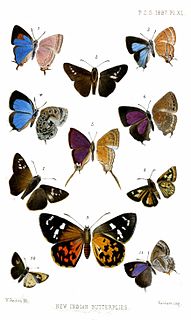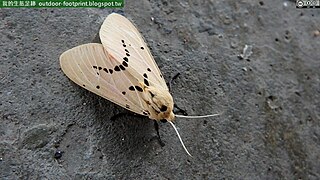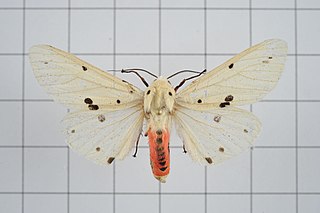
Elections to the United States House of Representatives were held in 1872 and 1873 for representatives to the 43rd Congress, coinciding with the re-election of U.S. President Ulysses S. Grant.

The buff ermine is a moth of the family Erebidae. It is sometimes placed in the genus Spilosoma. The species was first described by Johann Siegfried Hufnagel in 1766. It is found throughout the temperate belt of the Palearctic region south to northern Turkey, Georgia, Kazakhstan, southern Siberia, eastern Mongolia, Amur Region, China, Korea and Japan.

The Spilosomina are a subtribe of tiger moths in the tribe Arctiini, which is part of the family Erebidae.

Zinaspa is an Indomalayan genus of butterflies in the family Lycaenidae.

Spilarctia is a genus of moths in the family Erebidae. The genus was erected by Arthur Gardiner Butler in 1875.

Pterostichinae is a subfamily of ground beetles. It belongs to the advanced harpaline assemblage, and if these are circumscribed sensu lato as a single subfamily, Pterostichinae are downranked to a tribe Pterostichini. However, as the former Pterostichitae supertribe of the Harpalinae as loosely circumscribed does seem to constitute a lineage rather distinct from Harpalus, its core group is here considered to be the present subfamily and the Harpalinae are defined more narrowly.
Spilarctia rubilinea is a moth in the family Erebidae. It was described by Moore in 1866. It is found in Nepal, India, Bhutan, Myanmar, Vietnam and China.
Spilarctia leopardina is a moth in the family Erebidae. It was described by Vincenz Kollar in 1844. It is found in Tibet, Nepal, the north-western Himalayas and Kashmir.
Spilarctia melanostigma is a moth in the family Erebidae. It was described by Nikolay Grigoryevich Erschoff in 1872. It is found in Uzbekistan, Kyrgyzstan, Hissar, Pamirs, Afghanistan, Pakistan and from the Himalayas to Sikkim and Assam.
Spilarctia seriatopunctata is a moth in the family Erebidae. It was described by Motschulsky in 1861. It is found in Russia, China, Korea and Japan.
Spilarctia gopara is a moth in the family Erebidae. It was described by Moore in 1860. It is found in the Indian states of Sikkim and Assam and in Nepal.
Spilarctia punctata is a moth in the family Erebidae. It was described by Frederic Moore in 1859. It is found in India in Myanmar and on Java and possibly Borneo.

Spilarctia alba is a moth in the family Erebidae. It was described by Otto Vasilievich Bremer and William Grey in 1853. It is found in China, Taiwan and Korea.
Spilarctia bipunctata is a moth in the family Erebidae. It was described by Franz Daniel in 1943. It is found in Yunnan and Sichuan in China.
Spilarctia mona is a moth in the family Erebidae. It was described by Charles Swinhoe in 1885. It is found in southern India.
Spilarctia tigrina is a moth in the family Erebidae. It was described by Frederic Moore in 1879. It is found in southern India.
Eupterote todara is a moth in the family Eupterotidae. It was described by Frederic Moore in 1884. It is found in India.
Lymantria todara is a moth of the family Erebidae first described by Moore in 1879. It is found in India (Nilgiri) and Sri Lanka.






